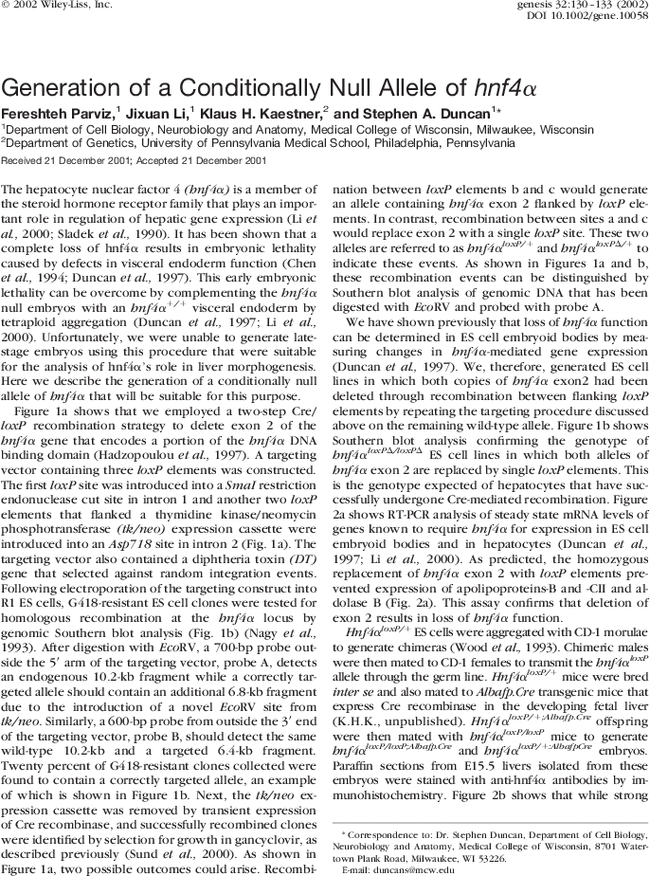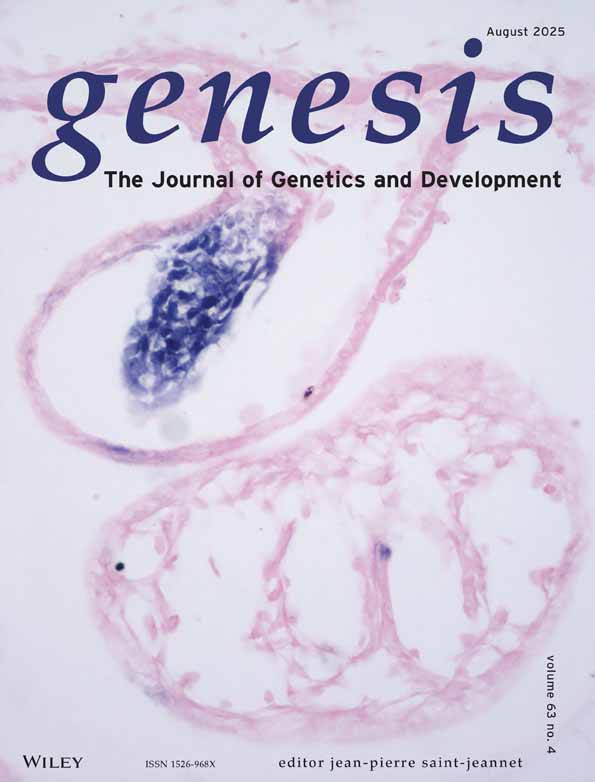Generation of a conditionally null allele of hnf4α
Fereshteh Parviz
Department of Cell Biology, Neurobiology and Anatomy, Medical College of Wisconsin, Milwaukee, Wisconsin
Search for more papers by this authorJixuan Li
Department of Cell Biology, Neurobiology and Anatomy, Medical College of Wisconsin, Milwaukee, Wisconsin
Search for more papers by this authorKlaus H. Kaestner
Department of Genetics, University of Pennsylvania Medical School, Philadelphia, Pennsylvania
Search for more papers by this authorCorresponding Author
Stephen A. Duncan
Department of Cell Biology, Neurobiology and Anatomy, Medical College of Wisconsin, Milwaukee, Wisconsin
Department of Cell Biology, Neurobiology and Anatomy, Medical College of Wisconsin, 8701 Watertown Plank Road, Milwaukee, WI 53226Search for more papers by this authorFereshteh Parviz
Department of Cell Biology, Neurobiology and Anatomy, Medical College of Wisconsin, Milwaukee, Wisconsin
Search for more papers by this authorJixuan Li
Department of Cell Biology, Neurobiology and Anatomy, Medical College of Wisconsin, Milwaukee, Wisconsin
Search for more papers by this authorKlaus H. Kaestner
Department of Genetics, University of Pennsylvania Medical School, Philadelphia, Pennsylvania
Search for more papers by this authorCorresponding Author
Stephen A. Duncan
Department of Cell Biology, Neurobiology and Anatomy, Medical College of Wisconsin, Milwaukee, Wisconsin
Department of Cell Biology, Neurobiology and Anatomy, Medical College of Wisconsin, 8701 Watertown Plank Road, Milwaukee, WI 53226Search for more papers by this author
LITERATURE CITED
- Chen WS, Manova K, Weinstein DC, Duncan SA, Plump AS, Prezioso VR, Bachvarova RF, Darnell JE Jr. 1994. Disruption of the HNF-4 gene, expressed in visceral endoderm, leads to cell death in embryonic ectoderm and impaired gastrulation of mouse embryos. Genes Dev 8: 2466–2477.
- Duncan SA, Nagy A, Chan W. 1997. Murine gastrulation requires HNF-4 regulated gene expression in the visceral endoderm: Tetraploid rescue of HNF-4-/- embryos. Development 124: 279–287.
- Hadzopoulou CM, Kistanova E, Evagelopoulou C, Zeng S, Cladaras C, Ladias JA. 1997. Functional domains of the nuclear receptor hepatocyte nuclear factor 4. J Biol Chem 272: 539–550.
- Li J, Ning G, Duncan SA. 2000. Mammalian hepatocyte differentiation requires the transcription factor HNF-4alpha. Genes Dev 14: 464–474.
- Nagy A, Rossant J, Nagy R, Abramow-Newerly W, Roder JC. 1993. Derivation of completely cell culture-derived mice from early passage embryonic stem cells. Proc Natl Acad Sci USA 90: 8424–8428.
- Sladek FM, Zhong W, Lai E, Darnell JE Jr. 1990. Liver-enriched transcription factor HNF-4 is a novel member of the steroid hormone receptor superfamily. Genes Dev 4: 2353–2365.
- Sund NJ, Ang SL, Sackett SD, Shen W, Daigle N, Magnuson MA, Kaestner KH. 2000. Hepatocyte nuclear factor 3beta (Foxa2) is dispensable for maintaining the differentiated state of the adult hepatocyte. Mol Cell Biol 20: 5175–5183.
- Wood SA, Allen ND, Rossant J, Auerbach A, Nagy A. 1993. Non-injection methods for the production of embryonic stem cell-embryo chimaeras. Nature 365: 87–89.




